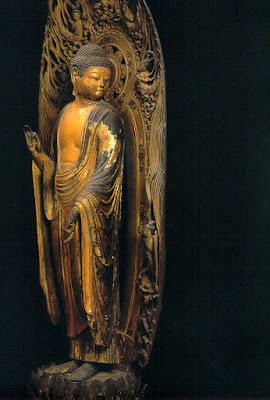A post-script to my previous post — Amida Buddha, buddha of infinite light and life
 |
| Amida Buddha, Zenrinji Temple, Kyoto |
On the church’s internal message board (we use SLACK) I tried to outline why I had done that. It seems not inappropriate to republish that piece here.
—o0o—
So here, in a nutshell, is why I added that link . . .
In Alfred Bloom’s “A Spiritual Odyssey: My Encounter with Pure Land Buddhism” he recalls that whilst working as a Christian missionary in Japan immediately following WWII he:
“had opportunity to give talks in Christian churches in English as a means of helping Japanese youth learn English and hear the Gospel. On one occasion, as I preached on the Christian idea of grace, the minister translated my words. He said, “This is like Amida.”
Many people (including me from 2007/8 onwards after discovering the work of Tanabe Hajime via Michael McGhee) have noticed a relationship between Shin Buddhism (Jōdo Shinshū) and Christianity, especially protestant Christianity in its liberal, universalist forms. This latter tradition is, of course, the one to which I, and the Unitarian movement as an historical entity, belong.
However, with the decline of belief in the idea of a theistic God held by orthodox Christianity what we have ended up with is a form of liberal humanism almost completely shorn of an object of devotion/worship around which it can gather (in the fashion that a community gathers around a common fire/hearth to cook, warm itself and to tell and pass on its experiences and stories) with a clean heart and full belief (pathos). In short we have ended up becoming an ethically concerned community without a shared narrative centre/gathering place.
Acknowledging this (perfectly understandable) lack of a credible centre around which we can all gather with a clean heart and full belief, in my own work I have striven — following Heidegger’s lead, who, in later life, became an admirer of Shinran and Shin Buddhism — to keep a space/clearing open to “prepare readiness, through thinking and poetry, for the appearance of the god or for the absence of the god” (Der Spiegel Interview with Martin Heidegger, 1966). The last time I wrote about this was here.
During the lockdown, my own personal exploration of the Shin Buddhist tradition has caused me to consider the possibility that the object of devotion/worship (or narrative centre) around which we might be able to gather with a clean heart and full belief as a free-thinking, liberal religious community with a liberal, universalist Christian back-story, is Amida Buddha.
I’m beginning to share with Alfred Bloom the intuition that I posted a few days ago on the #wednesday-evening-conversations channel. Namely:
“From my observation, I believe that Shinran’s thought completes the evolution of liberal religion as it has developed in western society. It permits a person to maintain a critical religious stance which is a key element in religious liberalism, while at the same time, it promotes a deep religious commitment and devotional perspective harmonious with intellectual endeavor. It makes possible a more integrated religious existence in the western context than is now provided for by many traditional western denominations. For Shinran’s teaching and Jodo Shinshu to reach its full potential, however, it will be necessary to deepen its dialogue and involvement with western intellectual and spiritual perspectives.”
You can find the quotation in the paper found at this link:
http://bschawaii.org/shindharmanet/wp-content/uploads/sites/3/2012/04/Amstutz.pdf
This is, of course, a new(ish) line of thinking for me in my formal role as a minister even as it’s now fourteen/fifteen years old in my personal thinking.
I would add that in the context of Advent/Christmas, by referring to us being children of “infinite life and life” I deliberately hoped to set up a resonance with a central idea of the season, namely, that “the light shines in the darkness, and the darkness did not conquer it” (John 1:5).
Whether we call this light/life God, God-or-Nature (deus sive natura) or Amida Buddha may, in the end, matter not a jot just as long as it is a light around which we can gather, encourage and warm ourselves and others in compassionate and creative ways.
Anyway, we shall see where this line of thinking eventually leads . . . but, in the meantime, thank you for your important prompt. Much appreciated!
As always,
Andrew



Comments